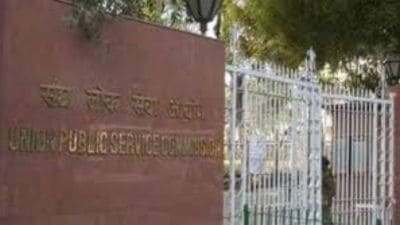- India
- International
Maharashtra: After years of drought, some in Jalna lose kharif crop to flood just days after sowing
Farm bunds and small water retention structures collapsed in heavy rainfall on June 18, bringing mud and silt to farmland in the trough between Kajla and Ghotan villages, located 15 to 20 km from Jalna city.
 Balasaheb Dake on his farmland on Friday.
Balasaheb Dake on his farmland on Friday.
IN DROUGHT-PRONE Jalna district’s Badnapur region, elated with the plentiful showers in the first week of June coinciding with Cyclone Nisarga and then more rainfall around June 8-10, Balasaheb Dake and other farmers in and around Kajla village had began sowing for an early kharif season for their cotton, pigeon pea, soybean and corn crops. By dusk this Thursday, however, 25-year-old Dake was standing in ankle-deep muck at the edge of his 14-acre farm that now resembled a lake.
Farm bunds and small water retention structures collapsed in heavy rainfall on June 18, bringing mud and silt to farmland in the trough between Kajla and Ghotan villages, located 15 to 20 km from Jalna city.
“I feel helpless, we are staring at one more year of losses,” Dake said. The last 10 to 12 days have brought heavy rainfall to the arid Marathwada region. While sowing is still underway in Beed, Hingoli, Aurangabad and Parbhani districts, farmers in large parts of Jalna completed their sowing early this week after the region received several plentiful showers.
While the normal average rainfall for Badnapur taluka at this time of the year is about 79 mm, as of Saturday the taluka recorded an average rainfall of 139.4 mm or more than 176 per cent of its normal average rain for June 20.
Villages around Roshangaon have received nearly 200 per cent of their normal rainfall. In neighbouring Bhokardan, too, average rainfall recorded Saturday was 200 per cent of the normal average for this time of the year.

“Those who are downstream of nullahs and natural streams were hit hard,” said Dake. “My field was flooded, like a river. The water level has receded now but my just-sprouting crop was washed out. The soil is also still mucky, and more rainfall is anticipated.”
Dake, a third-year law student, found himself suddenly the head of the family when his father died in 2015. A younger brother is studying in Pune. “I had never imagined that I would be a farmer. My father was a graduate too. We are a well-educated family. We have 14 acres of land. When I decided to take up agriculture, a few other youngsters in the village had followed my lead,” he said over the phone.
After the family incurred losses when their sweet lime orchard had to be hacked down during the last few years’ drought conditions, 2020 had appeared promising until Thursday’s rain when Dake’s nearly Rs 50,000 investment sank.
In Ghotan village, Vishnu Jagtap owns seven acres of farmland including a three-acre sweet lime orchard. “The trees had to be cut in 2012 when there was no rain, but my entire farmland was inundated on Thursday and Friday, with several inches of silt on the ground now. Worse, my drip irrigation system is destroyed — my losses are nearly Rs 2 lakh,” said Jagtap, 50.
A few hundred farmers in this belt are similarly affected, he said. No government survey has been initiated yet, but residents estimate that nearly 1,000 acres of farmland were damaged in this belt alone. Farm ponds, built with a subsidy from the government under a popular scheme, also collapsed.
Not far from the Ghotan-Kajla-Ranjangaon-Butegaon-Saigaon belt, the new Samruddhi Mahamarg, a super communication expressway is coming up. The ambitious high-speed road link between Mumbai and Nagpur will cut through parts of Marathwada. “While so much money is spent on the highway, corruption and disinterest will rob farmers of relief and better policy,” said Dake.
All of Jalna’s talukas show a similar trend of excess rain — Mantha has received 125 per cent of normal average until now, Ghansawangi received 166.9 per cent, Partur 134.6 per cent, Ambad 187.9 per cent, Jalna taluka 169.3 per cent, Jafrabad 187.6 per cent and Bhokardan 198.4 per cent.
Other districts in Marathwada have received rainfall above normal averages as well. By Saturday, Aurangabad received 161.4 mm (normal average 65.9 mm), Beed 141.9 mm (73.9 mm), Jalna 112.3 mm (67.7 mm), Latur 135.5 mm (68.5mm), Nanded 100.2 mm (65.3 mm), Hingoli 118.6 mm (71.6 mm), Parbhani 129.2 mm (69.8 mm) and Osmanabad 119.3 mm (73.9 mm).
Buzzing Now
Apr 16: Latest News
- 01
- 02
- 03
- 04
- 05






































